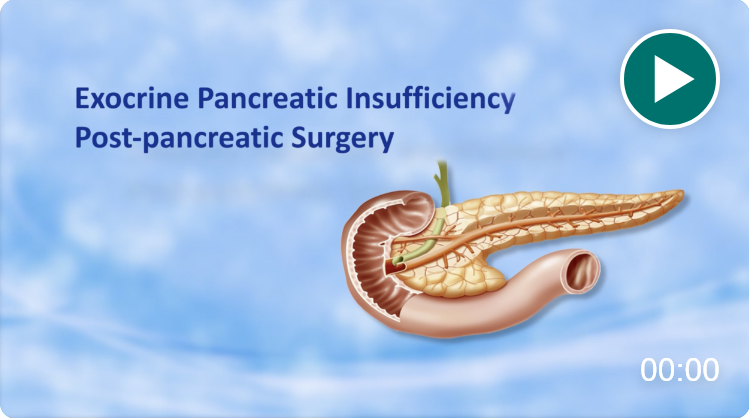
EPI Education
Take a deep dive into EPI and learn from experts in the field.
About EPI: EPI pathogenesis, symptoms, and diagnosis
Etiologies of EPI: Recognize EPI and the barriers to diagnosis
Management of EPI: Key information for managing EPI
Case Studies: Experts present case-based narratives on EPI
Select one or more filters below to explore topic-specific resources.
Transcript
Many conditions of the pancreas are treated surgically. Anywhere from enucleation of a small lesion up to total pancreatectomy. Variations in the types of pancreatic resection and ductal drainage procedures can apply to patients with chronic pancreatitis and pancreatic cancer.
Exocrine pancreatic insufficiency, abbreviated EPI, is a common outcome following pancreatic surgery and is defined by a reduction in the quantity or activity of pancreatic enzymes necessary to maintain normal digestion.
The clinical signs and symptoms of EPI vary greatly. Many patients experience no clinical symptoms or have nonspecific bloating, flatulence, and abdominal discomfort, which may be attributed to other GI conditions or to the post-operative state. Specific symptoms of EPI include fat malabsorption, known as steatorrhea, as well as unintentional weight loss, and clinically relevant malnutrition, as well as micronutrient deficiencies.
The frequency and severity of post-surgical EPI depends on the volume and function of the remnant pancreas after surgical resection, which may remove 50 percent or more of total pancreatic volume. Pancreatic function may be further impaired by fibrosis and longstanding pancreatic duct obstruction causing atrophy. Further, surgical alterations of the foregut can impair intestinal motility and delivery of enzymes and bile relative to a food bolus and may cause ineffective digestion. Because surgery can cause progressive deterioration in exocrine function, laboratory results may fluctuate with time. Current U.S. guidelines do not prescribe the timing of post-operative assessment for EPI. Studies performed at 30 and 90 days after surgery are unlikely to capture all patients with potential EPI.
EPI may be present prior to surgery due to the destruction of pancreatic parenchyma caused by fibrosis or tumors obstructing the pancreatic duct. Rates of pre and post-operative EPI depend on the patient population. For example, in patients undergoing pancreaticoduodenectomy for pancreatic adenocarcinoma, rates of EPI are reported between 40 and 70 percent before surgery and may rise to 55 to 90 percent after surgery.
The nutritional impact of pancreatic resection is often under-appreciated. Pancreatectomy causes maldigestion and malabsorption, leading to poor nutritional status, which adversely affects clinical outcomes as well as quality of life.
Pre-operative weight loss and poor nutritional status are significant factors for a number of potentially modifiable adverse events after surgery including post-operative pancreatic fistula, surgical site infections, increased length of hospital stay, and increased mortality. Moreover, several single-center studies of patients undergoing pancreatectomy for diverse indications have identified malnutrition as a risk factor for re-admission to the hospital.
What do current guidelines recommend regarding the significant burden of exocrine pancreatic insufficiency among patients with pancreatic cancer, and specifically those requiring surgery? Multiple guidelines recognize EPI as a post-operative condition among patients undergoing pancreatic surgery. The National Comprehensive Cancer Network Guidelines state that exocrine pancreatic insufficiency occurs in up to 94 percent of patients with pancreatic adenocarcinoma undergoing surgery. ASCO Clinical Practice Guidelines suggest that patients with potentially curable pancreatic cancer merit a consultation with a nutritionist or a dietitian if that service is available due to the prevalence of anorexia and weight loss. Dietary intake should be assessed, along with the potential need for nutritional supplements. And recommendations are made for patients who are experiencing symptoms consistent with exocrine pancreatic insufficiency.
Given the prevalence of post-op EPI, a position paper from the International Study Group on Pancreatic Surgery recommends that surgical patients undergo routine post-operative evaluation of exocrine pancreatic function regardless of the type of pancreatic resection and reconstruction.
Despite its prevalence after surgery, the diagnosis of pancreatic exocrine insufficiency remains challenging. Surgeons’ practices assessing and treating exocrine pancreatic insufficiency are variable. In one survey of pancreatic surgeons, 52.5 percent reported assessing their patients for EPI pre-operatively. Among them, 48.5 percent did so routinely, while the other 51.5 percent assessed for EPI only in the presence of diarrhea or steatorrhea in the setting of high risk pathology, such as chronic pancreatitis. A third of surgeons did not objectively test for EPI, but relied on clinical symptoms to make the diagnosis.
Post-surgical patients often experience gastrointestinal alterations like delayed gastric emptying or dumping syndrome, which make the differential diagnosis of EPI challenging. Patients often self-treat with a fat-restricted diet to minimize their symptoms, which unfortunately, masks their underlying EPI and causes further weight loss or malnutrition. Referral to a dietician is infrequent and may occur in as few as 36 percent of affected patients.
Confirmation of exocrine pancreatic insufficiency is usually not practical in clinical practice. The gold standard diagnosed to test for EPI is a difficult and cumbersome test known as the coefficient of fat absorption, or CFA. Correlations between CFA and simple tests like fecal elastase 1 are poor, meaning that EPI remains largely a clinical diagnosis based on patients’ symptoms and history.
In summary, pre- and post-operative nutritional status plays an important role in surgical outcomes and may modify the risk of post-operative adverse events. EPI is a frequent but under-recognized consequence of pancreatic surgery, which contributes to poor nutritional status and weight loss among surgical patients. The post-operative diagnosis of EPI may be obscured by post-surgical GI complications, the lack of an ideal test, as well as uncertainty about an optimal time for confirmatory laboratory testing. Keeping that in mind, the International Study Group on Pancreatic Surgery recommends routine monitoring for EPI in these patients.

EPI in Pancreatic Surgery
Recognize EPI after pancreatic surgery and the challenges in postoperative diagnosis.

Take an immersive journey into the physiology of the exocrine pancreas and the pathophysiology of EPI.

















